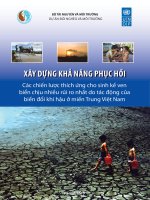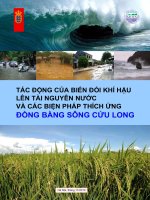bài giảng: Tác động của biến đổi khí hậu
Bạn đang xem bản rút gọn của tài liệu. Xem và tải ngay bản đầy đủ của tài liệu tại đây (2.21 MB, 28 trang )
Lecture 16
Impact of Climate Change
Two main effects associated with climate
change:
(1) An increase in global mean temperature
discussed in a number of lectures (global warming).
(2) An increase in evaporation everywhere, driven
by increased greenhouse gas concentrations and
increased temperatures. The increase in
evaporation also implies an increase in
precipitation, because the atmosphere can’t store
water vapor indefinitely. There is no clear
consensus on how the increase in precipitation will
be distributed. However, we do know that it will
not be distributed uniformly. This increase in
evaporation and precipitation is known as the
intensification of the hydrologic cycle.
Projection to the future? (globe and regions)
Global mean surface temperature change based on surface air measurements over land and
SSTs over ocean. Source: Update of Hansen et al., JGR, 106, 23947, 2001; Reynolds and
Smith, J. Climate, 7, 1994;Rayner et al., JGR, 108, 2003 (afterJames E.Hansen 2006).
Weather Forecast
“The weather man does it with a crystal
ball” Don’t remember the source
Projection of Future Climate Change
“Our crystal balls are computer models
(GCMs) and satellite data”
Something to do with Greenhouse
Warming
“It is difficult to get a man to understand
something when his salary depends upon
his NOT understanding it”
Uptown Sinclair (from the file Anthony Stier sent me)
An Inconvenient Truth Al Gore (2006)
Uncertainty about the future: This plot shows the upper
and lower limits of the warming over the coming
century predicted by current GCM simulations.
This range is
due to two
factors: (1)
uncertainty
in emissions
scenarios
and (2)
different
model
sensitivities
(i.e. different
simulations
of climate
feedbacks).
1938
Climate Change Impacts
1981
Grinnell Glacier
Glacier National Park
Mountain glaciers all
over the world are in
retreat. This is the
Qori Kalis glacier in
Peru in 1978.
Here is the same
glacier in the year
2000. The lake covers
10 acres.
From space, we can monitor the extent of melting of
the world’s major ice sheets. Greenland has
experienced a large increase in melting over the past
few decades. Images courtesy of Konrad Steffen and
Russell Huff, CIRES, University of Colorado at Boulder
Arctic researchers see early warming signals
1979
2000
Based on satellite data, these images show Arctic sea ice.
The ice cover shrunk by 9 percent a decade over that time.
Why will sea level rise as the climate
warms?
We discussed the effect of changes in the
size of glaciers and ice sheets on sea level
in the context of the 100,000 year
glacial-interglacial cycles that have
characterized Earth’s climate over the
past 1 million years.
In addition, sea level will rise as the
climate warms due to the thermal
expansion of seawater, i.e., the fact that
seawater expands as it warms.
Bangladesh, one of the world's poorest nations, is also the country most vulnerable to
sea-level rise. The population is already severely affected by storm surges.
Catastrophic events in the past have caused damage up to 100 km inland.
At present expected rates of sea level rise,
this scenario would occur something like 150
years from now.
About 2/3 of the observed sea level rise is
probably attributable to thermal expansion of
seawater; the remainder is due to melting of
glaciers
Another important issue: The
intensification of the hydrologic cycle
Earth’s water budget. The units of the water flows are
thousands of cubic kilometers per year.
Increase in
greenhouse
gases means
more longwave
radiation
reaches the
surface
Increase in
temperatures
favors loss of
surface heat through
evaporation rather than
sensible heat
HYDROLOGIC CYCLE
INTENSIFICATION
Increase in
evaporation
(fairly uniform
globally)
Increase in
precipitation
(not
uniform)
Effect on Ecosystems
Ecosystems will be forced to
adapt to climate change for two
reasons:
(1) temperatures will be warmer.
(2) precipitation will be
distributed differently.
One easily anticipated effect of climate change is species migration to
higher latitudes. For example, a warmer climate may have significant
effect on forests composition. Decidous forests will probably move
northwards and to higher altitudes, replacing coniferous forests in
many areas. Some tree species will probably be replaced altogether,
jeopardizing biological diversity.
Species would also migrate to higher altitudes. The figure
shows a comparison of current vegetation zones at a
hypothetical dry temperate mountain site with simulated
vegetation zones under a climate-warming scenario.
Species and ecosystems with limited climatic ranges could
disappear.
Climate Change Projection by
Computer Models: Regional
Impact, California
Oct 17, 2003 MISR
Rising Temperatures
California statewide
Projected average summer temperature
changes
Source: A Luers/Union of Concerned Scientists
Diminishing Sierra Snowpack
% Remaining, Relative to 1961-1990
This shows how the
more sensitive global
model projects
snowpack to change
in the Sierras. The
change in snowpack
is significant because
it comprises
approximately half
the total water
storage capacity of
California, the other
half being contained
mainly in humanmade reservoirs.
Source: A Luers/Union of Concerned Scientists









